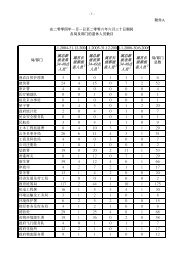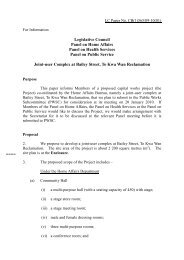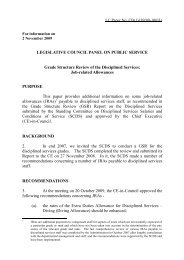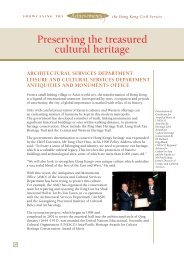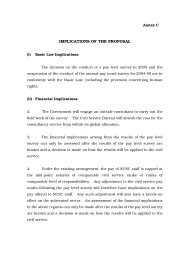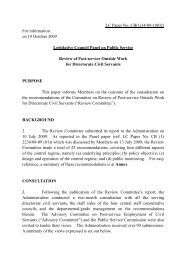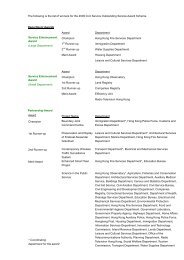Interview with Mr Patrick Chan, BBS, JP Director of ... - å ¬åå¡äºåå±
Interview with Mr Patrick Chan, BBS, JP Director of ... - å ¬åå¡äºåå±
Interview with Mr Patrick Chan, BBS, JP Director of ... - å ¬åå¡äºåå±
- No tags were found...
You also want an ePaper? Increase the reach of your titles
YUMPU automatically turns print PDFs into web optimized ePapers that Google loves.
website content as requested. Web servers areessentially “serving” the many users on the Web,similar to the storefront <strong>of</strong> shops.How does a website run on a web server? Firstly,a website comprises many web pages. Webpages are typically stand-alone files, <strong>with</strong> the enddenoted as “.html” or “.htm”. They are written ina common language known as the Hyper-textMarkup Language (HTML). Web pages arestored as HTML files on the Web server, andare made available for fetching by the user whenrequested. The entire HTML file will be sent backto the user and be displayed on a Web browser.All Web browsers are built to understand andprocess HTML files, much like having a commonlanguage to speak in the real world. In short,HTML is a universal language for presentation<strong>of</strong> data in Web browsers.The primary purpose <strong>of</strong> HTML is to properlyformat and display static information on a Webbrowser. The HTML is derived from the concept<strong>of</strong> “marking up” a document, <strong>with</strong> tags to annotatethe display styles <strong>of</strong> elements in a document.Textual information in a web page is stored in thecorresponding HTML file. If a web page needsto incorporate images, instead <strong>of</strong> containing theimage itself, the HTML file contains a referenceto where the image is placed. The same conceptapplies to other multimedia information, such asmovies. For example, most animations displayedon the Web nowadays are in the format <strong>of</strong> AdobeFlash videos. A Flash Video file is separatelystored and will be embedded into a web page filevia a reference.Different pages <strong>of</strong> a website are interconnected<strong>with</strong> hyperlinks. As an HTML feature, hyperlinksare special text on a web page that redirects auser to another page when clicked. They areusually highlighted in blue and underlined to bedistinguished from normal text.In summary, since all Web browsers are capable<strong>of</strong> interpreting and displaying HTML, websites built<strong>with</strong> HTML files can be presented consistently byall computers through a Web browser.Beyond Static Presentation –Dynamic Websites and ProcessingVery <strong>of</strong>ten websites have interactive componentsthat process incoming information and produceoutputs based on user inputs. A simple examplewould be a search engine. A user types in akeyword, such as “chocolate”, into a textbox andthe search engine will return relevant websitesand information on chocolate. The ability <strong>of</strong> thewebsite to process the keyword is beyond thescope <strong>of</strong> HTML, which is only responsible fordisplay and formatting. Websites capable <strong>of</strong>producing different results based on differentinputs are under the concept <strong>of</strong> dynamicwebpage generation. This concept is driven byanother important technology known as serversidescripting which allows Web servers toemploy customised programming to controldynamic outputs <strong>of</strong> a website. With server-sidescripting technology, a web server can generateweb pages containing processed informationbased on inputs received by users. Some popularserver-side scripting technologies are PHP, ASP.NET and JSP. It is important to note that whilethe file types have changed, the output format isstill expressed in HTML codes. The relationshipbetween server-side scripting technology andHTML pages can be expressed as a projector –the projector (server-side scripting) will projectdifferent images (HTML pages) as required bythe user, based on user input.ConclusionThe dissection <strong>of</strong> the Web begins <strong>with</strong>understanding the basic concept <strong>of</strong> transmission<strong>of</strong> information over the Internet followed bythe concept <strong>of</strong> how information is universallypresented on websites <strong>with</strong> HTML. To further thestudy <strong>of</strong> the Web and its revolutionary impact, thisarticle has briefly introduced server-side scriptingtechnology. While HTML has facilitated simpleinformation sharing over the Web, it is server-sidescripting technology that truly revolutionises theuse <strong>of</strong> the Internet for a multitude <strong>of</strong> purposes.Through web-based IT systems, Internet userscan now trade stocks, pay taxes, keep in touch<strong>with</strong> friends and families afar, and even runbusinesses. To date, these important buildingblocks <strong>of</strong> the Web are constantly being developedand enhanced, trailblazing even more inspiringand creative inventions to benefit the immersiveon-line experience.Raymond SzetoEOII(Antiquities & Monuments)Leisure and Cultural Services Department 15





